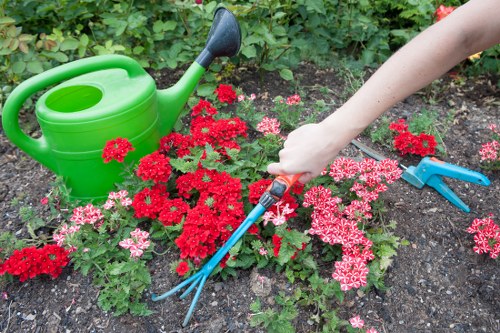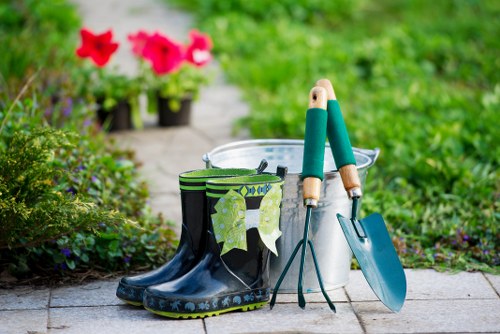Lawn Mowing in Leaves Green: Keeping Your Grass Lush and Healthy

Maintaining a beautiful, green lawn in Leaves Green requires consistent care and attention. Lawn mowing is a fundamental aspect of lawn maintenance that not only enhances the aesthetic appeal of your property but also promotes healthy grass growth. In this comprehensive guide, we will explore the best practices for mowing your lawn in Leaves Green, ensuring it stays green and thriving throughout the seasons.
Understanding the climate and soil conditions in Leaves Green is crucial for effective lawn care. The area's temperate climate provides ideal growing conditions for a variety of grass types. However, factors such as soil quality, moisture levels, and sunlight exposure can significantly impact the health of your lawn. By tailoring your mowing practices to these local conditions, you can achieve a vibrant and resilient lawn that stands out in the neighborhood.
Choosing the right mowing equipment is another essential step in maintaining a green lawn. Whether you prefer a traditional push mower or a state-of-the-art electric model, selecting the appropriate tool can make a substantial difference in the quality of your mow. A well-maintained mower ensures clean cuts, reduces the risk of disease, and promotes even grass growth.

Best Practices for Mowing Your Lawn
To keep your lawn in Leaves Green looking its best, follow these mowing best practices:
- Maintain the Right Height: Cutting your grass to the optimal height encourages deeper root growth and better nutrient absorption. For most grass types, a height of 2.5 to 3.5 inches is ideal.
- Mow Regularly: Regular mowing prevents overgrowth and encourages a dense, healthy lawn. Aim to mow once a week during the growing season.
- Sharp Blades: Ensure your mower blades are sharp to make clean cuts. Dull blades can tear grass, leading to a ragged appearance and increased susceptibility to disease.
Implementing these practices will not only enhance the appearance of your lawn but also contribute to its long-term health and sustainability.
Additionally, varying your mowing pattern each time you mow can prevent soil compaction and encourage grass to grow in different directions, resulting in a more uniform lawn.

Seasonal Lawn Care Tips
Each season brings unique challenges and opportunities for your lawn. Adapting your mowing schedule and techniques to the changing seasons can help maintain the lushness of your grass:
- Spring: As the grass begins to grow, increase your mowing frequency. This is also the time to fertilize and aerate your lawn.
- Summer: Mow less frequently to avoid stressing the grass. Ensure consistent watering to keep the lawn green.
- Fall: Maintain regular mowing to remove fallen leaves and prepare the lawn for winter.
- Winter: Reduce mowing frequency as grass growth slows. Clear any debris to protect the lawn from harsh weather.
By aligning your mowing practices with the seasons, you can support the natural growth cycles of your grass, ensuring a healthy and green lawn all year round.
Proper seasonal care also involves adjusting your mowing height to accommodate the growth patterns of your grass during different times of the year.

Selecting the Right Grass Type
The choice of grass type plays a significant role in the overall health and appearance of your lawn. In Leaves Green, common grass varieties include Kentucky bluegrass, perennial ryegrass, and fescue. Each type has its own set of characteristics and maintenance requirements:
- Kentucky Bluegrass: Known for its rich color and fine texture, it requires regular mowing and watering.
- Perennial Ryegrass: Offers rapid establishment and a dense growth habit, making it ideal for high-traffic areas.
- Fescue: Tolerates shade well and is relatively low-maintenance, suitable for various soil types.
Selecting a grass type that aligns with your lawn's conditions and your maintenance capabilities will ensure a greener and more resilient lawn.
Furthermore, consulting with local lawn care experts in Leaves Green can provide valuable insights into the best grass varieties for your specific area.

Lawn Mowing Techniques
Employing effective mowing techniques can significantly enhance the health and appearance of your lawn. Here are some key techniques to consider:
- Mow When Dry: Mowing wet grass can lead to uneven cuts and clumping, which may foster disease.
- Avoid Cutting More Than One-Third: Removing too much grass at once can stress the lawn. Stick to cutting no more than one-third of the grass height in a single mowing session.
- Leave Clippings on the Lawn: Grass clippings can provide natural fertilizer, returning valuable nutrients to the soil.
Implementing these techniques promotes healthy grass growth and reduces the need for additional fertilizers and treatments.
Additionally, walking in different mowing patterns each time helps prevent soil compaction and encourages grass blades to grow upright, enhancing the lawn's overall appearance.
Local Services and Resources in Leaves Green
Living in Leaves Green offers access to a variety of local lawn care services and resources. Whether you prefer to mow your lawn yourself or hire professionals, here are some options available in the area:
- Professional Lawn Care Services: Local companies offer comprehensive lawn mowing, trimming, and maintenance services tailored to your specific needs.
- Lawn Supply Stores: Access to high-quality mowing equipment, fertilizers, and other lawn care products.
- Community Workshops: Learn about effective lawn care practices through workshops and seminars hosted by local gardening clubs.
Utilizing these local resources can enhance your lawn care routine and ensure you have the support and tools necessary to maintain a green and healthy lawn.
Additionally, connecting with neighbors and participating in community initiatives can provide valuable tips and shared resources for lawn maintenance.
Benefits of a Well-Mowed Lawn
A regularly mowed lawn offers numerous benefits beyond the obvious aesthetic appeal:
- Healthier Grass: Regular mowing promotes stronger root systems and more vigorous grass growth.
- Weed Control: Keeping the grass at an optimal height can prevent weeds from taking hold and spreading.
- Enhanced Curb Appeal: A well-maintained lawn enhances the overall appearance of your property, increasing its value.
Moreover, a healthy lawn can provide a safe and inviting space for outdoor activities and relaxation.
Investing time and effort into proper lawn mowing practices yields long-term rewards, ensuring your lawn remains a source of pride and enjoyment.
Environmental Impact
Proper lawn mowing not only benefits your property but also has positive environmental implications:
- Carbon Sequestration: Healthy grass absorbs carbon dioxide, contributing to cleaner air.
- Erosion Control: A well-mowed lawn helps prevent soil erosion, especially during heavy rains.
- Habitat Support: Lawns provide habitats for various insects and small wildlife.
By maintaining a green lawn in an environmentally responsible manner, you contribute to the local ecosystem and promote sustainability.
Additionally, using eco-friendly mowing practices, such as electric mowers, can further reduce your lawn's environmental footprint.
Challenges in Lawn Mowing
Maintaining a green lawn in Leaves Green comes with its own set of challenges. Understanding these obstacles can help you devise effective strategies to overcome them:
- Pest Management: Insects and pests can damage the grass, leading to discoloration and thinning.
- Disease Prevention: Fungal diseases can thrive in certain conditions, affecting the health of your lawn.
- Weather Extremes: Unpredictable weather patterns, including droughts and heavy rains, can stress the grass.
Addressing these challenges proactively ensures the longevity and robustness of your lawn.
Implementing integrated pest management and regular monitoring can mitigate the impact of these challenges.
Solutions and Preventative Measures
To tackle the challenges associated with lawn mowing, consider the following solutions:
- Regular Monitoring: Keep an eye out for signs of pests or diseases and address them promptly.
- Proper Watering: Ensure your lawn receives adequate moisture without overwatering, which can lead to root rot.
- Balanced Fertilization: Use appropriate fertilizers to provide essential nutrients without causing buildup.
By adopting a proactive approach, you can maintain a resilient and green lawn even in the face of challenges.
Additionally, scheduling regular check-ups with lawn care professionals can provide expert insights and timely interventions.
Local Areas Near Leaves Green for Lawn Mowing Services
Residents of Leaves Green have access to professional lawn mowing services in the surrounding areas. Here are some of the closest areas where you can find reliable lawn care providers:
- Greenfield: Located just 5 miles north, Greenfield offers a range of lawn mowing services with experienced technicians.
- Maplewood: 7 miles to the east, Maplewood is known for its eco-friendly lawn care solutions.
- Sunnyside: Situated 6 miles south, Sunnyside provides affordable and comprehensive lawn maintenance packages.
- Oakridge: 8 miles west, Oakridge features specialized services for organic lawn care enthusiasts.
- Cedar Park: 4 miles northeast, Cedar Park offers premium mowing equipment and skilled professionals.
- Pine Valley: 10 miles southeast, Pine Valley is renowned for its personalized lawn care plans.
- Willow Creek: 9 miles southwest, Willow Creek provides prompt and reliable mowing services.
- Brookside: 3 miles northwest, Brookside specializes in landscaping and lawn maintenance.
- Elmwood: 7 miles northwest, Elmwood offers competitive pricing and high-quality service.
- Riverbend: 6 miles southeast, Riverbend is known for its dedicated and professional lawn care teams.
These nearby areas provide a variety of options to suit different budgets and preferences, ensuring that residents of Leaves Green can find the perfect lawn mowing services to keep their lawns green and healthy.
Exploring these local services can help you find the best fit for your lawn care needs, whether you require regular mowing, specialized treatments, or comprehensive landscaping services.
Conclusion
Maintaining a green lawn in Leaves Green is a rewarding endeavor that enhances the beauty and value of your property. By following best practices for lawn mowing, selecting the right grass type, and leveraging local resources, you can achieve a healthy and lush lawn that thrives year-round.
Addressing seasonal changes, managing challenges, and choosing the right services are key components of successful lawn care. Whether you prefer a hands-on approach or prefer to hire professionals, the strategies outlined in this guide will help you maintain a vibrant and green lawn that you can be proud of.
Frequently Asked Questions
1. How often should I mow my lawn in Leaves Green?
During the growing season, it is recommended to mow your lawn once a week. However, this may vary depending on the grass type and growth rate. Always mow when the grass is dry and never remove more than one-third of the grass height at a time.
2. What is the best grass type for wet climates?
Perennial ryegrass and fescue are excellent choices for wet climates as they are more tolerant of moisture and can withstand varying soil conditions commonly found in such environments.
3. Should I leave grass clippings on the lawn?
Yes, leaving grass clippings on the lawn is beneficial as they act as a natural fertilizer, returning nutrients to the soil and promoting healthier grass growth. Ensure clippings are not too long to prevent smothering the grass.
4. How can I prevent weeds from taking over my lawn?
Regular mowing, proper fertilization, and maintaining the right grass height are effective ways to prevent weed growth. Additionally, using pre-emergent herbicides in early spring can help inhibit weed seeds from germinating.
5. When is the best time to fertilize my lawn?
The best times to fertilize your lawn are in the early spring when growth begins and again in the fall to prepare the grass for winter. Avoid fertilizing during the peak of summer to prevent stress on the grass.
Frequently Asked Questions
Get In Touch With Us.
Please fill out the form below to send us an email and we will get back to you as soon as possible.